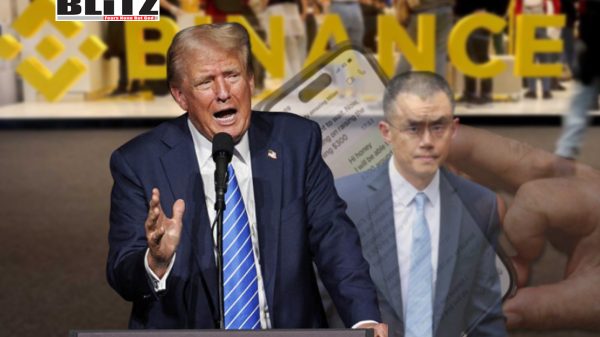Crypto giants linked to billions in laundered funds and global crime rings
- Update Time : Friday, November 21, 2025

The cryptocurrency industry, once heralded as a transformative financial revolution, has been revealed to be a fertile ground for illicit activity on a massive scale. A detailed investigation by the International Consortium of Investigative Journalists (ICIJ), alongside 37 media partners in 35 countries, has traced tens of thousands of transactions and uncovered how some of the world’s largest crypto exchanges have facilitated billions of dollars in illicit flows, often linked to organized crime, human trafficking, and state-backed cyber theft.
This sprawling exposé, named The Coin Laundry, paints a troubling picture of an industry that, despite pledges to comply with anti-money laundering regulations, remains deeply entwined with criminal enterprises. It also underscores the role political decisions play in shaping the regulatory environment of digital currencies, with President Donald Trump’s pardon of Binance founder Changpeng “CZ” Zhao acting as a pivotal moment in this narrative.
The rise of Binance and its regulatory troubles
Changpeng Zhao founded Binance in 2017, quickly propelling it to become the world’s largest cryptocurrency exchange. Binance’s meteoric growth was fueled by low transaction fees, high-volume trading technology, and an aggressive willingness to list new digital assets. The exchange sponsored international sports events, including soccer and Formula 1 racing, and even facilitated the launch of digital tokens for global icons like Cristiano Ronaldo. By the end of 2023, Binance accounted for approximately half the trading volume across the largest cryptocurrency platforms-an estimated $18.4 trillion out of a total $35.2 trillion, according to CoinGecko research.
Yet, alongside this unprecedented growth, Binance drew scrutiny from US authorities. In November 2023, Zhao and Binance pleaded guilty to operating without essential anti-money laundering (AML) safeguards, exposing the exchange to allegations that it had authorized transactions for “terrorists, cybercriminals, and child abusers.” Zhao agreed to step down as CEO, pay a $50 million fine, and comply with court-mandated monitoring aimed at ensuring AML compliance.
Despite these measures, Binance continued to profit from transactions tied to notorious criminal networks. Between July 2024 and July 2025, analysis by ICIJ revealed that at least $408 million flowed to Binance accounts from Huione Group, a Cambodia-based firm used by Chinese crime syndicates to launder proceeds from human trafficking, online scams, and industrial-scale fraud operations.
OKX and the continued flow of dirty money
Binance was not alone. OKX, another major cryptocurrency exchange, also pleaded guilty in February 2024 to operating an illegal money transmitter and agreed to engage a court-appointed compliance consultant. Yet customer accounts at OKX continued to receive hundreds of millions of dollars from Huione, including over $161 million after the US Treasury Department labeled Huione a “primary money laundering” concern in May.
Ross Delston, a lawyer specializing in anti-money laundering law, remarked, “Normally that halts everything. If the federal government just told you that this entity is a high risk for money laundering or terrorist financing, you’d be crazy to continue any financial dealings with them.”
Both Binance and OKX claimed to cooperate with global law enforcement and monitor suspicious deposits. Binance said that crypto technology inherently limits its ability to block incoming funds, and OKX emphasized its proactive engagement with law enforcement. Yet the ICIJ investigation shows that in practice, enforcement and compliance are often insufficient.
Cryptocurrency exchanges as tools for crime
The Coin Laundry investigation demonstrates that major exchanges have become indispensable tools for laundering funds from diverse criminal networks, including North Korean hackers, Russian money launderers, and drug cartels. Exchanges function as quasi-banks in the crypto ecosystem, allowing users to store funds and make transactions while remaining outside traditional financial oversight. Unlike conventional bank accounts, crypto holdings are not federally insured, yet they offer fast, efficient means to convert illicit digital assets into liquid currency.
John Griffin, a blockchain data expert at the University of Texas at Austin, explained, “If they kick criminal actors off the platform, that’s a big revenue source they lose, so they have an incentive to allow this activity to continue. Crypto offers criminals a financial system that’s very efficient compared to the old days when a cartel would have to stuff cash into the back of a Cadillac.”
ICIJ analysis revealed that Binance accounts handled more than $250 million in transactions for Hydra Market, a Russian darknet marketplace linked to drugs, stolen credit cards, and child sexual abuse content. Other exchanges, including OKX and HTX, also facilitated the flow of funds from North Korean cyber thefts, Chinese fentanyl trafficking operations, and Russian money laundering networks.
Huione: A case study in persistent Illicit activity
The Cambodia-based Huione Group represents a stark example of how criminal enterprises exploit crypto exchanges. Its operations involve hundreds of human trafficking victims working in Southeast Asia scam centers, contacting unsuspecting victims through social media or posing as tech support and investment managers. Scammers would lure victims to fake cryptocurrency platforms, creating the illusion of growing investment balances while immediately laundering the funds through legitimate exchanges like Binance and OKX.
ICIJ traced tens of thousands of transactions from Huione, finding that an average of $1 million per day in tether was sent to Binance customer accounts. Even after the group was officially labeled a high-risk entity for money laundering by the Treasury Department, the flow of funds continued largely unimpeded. OKX customer accounts received at least $226 million from Huione after pleading guilty to operating an illegal money transmitter.
The investigation leveraged blockchain analytics firms such as Arkham Intelligence and Tronscan to verify the exchanges’ involvement in processing these funds. Despite these insights, Binance maintained that its monitoring systems and compliance protocols were “robust” and “multilayered,” while OKX described a combination of AI-driven systems and experienced personnel for transaction oversight.
North Korean hackers and the THORChain connection
In February 2025, North Korean hackers carried out a $1.5 billion heist from Dubai-based exchange Bybit, funding the country’s nuclear weapons program. The stolen ether flowed through THORChain, a crypto swapping service that converts one cryptocurrency into another. ICIJ found that Binance received more than $900 million in ether from THORChain in just ten days while the stolen funds were being laundered.
Although there is no evidence that Binance directly controlled North Korean accounts, blockchain analysts argue that the exchange should have acted once it became a conduit for large sums coming from a known money-laundering service. Jonathan Reiter, CEO of ChainArgos, told ICIJ, “Even a bad – maybe even defective – screening tool would spot that.”
Russian criminal networks and global money laundering
Russian-speaking crime networks have similarly exploited exchanges to launder money for cartels, ransomware operations, and espionage. Operation Destabilise, a UK-led investigation in 2024, exposed two major money laundering networks exchanging cryptocurrency for cash and vice versa. U.S.-based Kraken reportedly provided accounts facilitating bulk exchanges for one of the networks, while Binance and other major exchanges also processed significant transactions.
Between 2019 and 2021, one wallet linked to the Smart group, a Russian-speaking criminal network, sent or received at least $40 million in cryptocurrency via Binance. Other exchanges like WhiteBIT and HTX were similarly implicated in moving funds for these networks. The pattern underscores how market-leading exchanges, while ostensibly legitimate, are often deeply entwined with criminal financial flows.
Victims left behind
While major exchanges profit from transactions, individual victims of crypto scams face near-total impunity. ICIJ interviews across four continents revealed widespread devastation. In Canada, 58-year-old Carrissa Weber lost $25,000 to a fraudulent startup that promised both investment opportunities and hourly work. Despite reporting the theft, authorities were largely unable to recover her funds, which ended up in OKX accounts linked to Huione.
In Japan, 68-year-old Asako Nishizaki lost $74,000 over three and a half years to a romance scam that relied on cryptocurrency transfers. She had to move into social housing after losing her life savings. In the US, a Minnesota father lost over $1 million to a phony investment platform, ultimately tracing half a million dollars to Binance accounts using private blockchain investigators.
These stories illustrate the human cost of insufficient oversight in the crypto industry. While exchanges facilitate legitimate trading, they also provide a safe haven for criminal actors, often leaving victims without recourse.
Compliance, oversight, and the limits of regulation
Compliance teams at major exchanges face enormous challenges. Former employees report understaffing, insufficient resources, and overwhelming volumes of transactions. Alerts for suspicious activity are numerous, but limited resources and procedural constraints make detailed investigation nearly impossible.
For instance, Alessio Della Santa, a former Binance compliance officer, explained, “When it’s only for $2 or $3, you’re like, ‘What am I even doing?’ You’re losing time. You could have been checking more important cases.” He also noted that critical account information, such as home addresses, was often missing, preventing meaningful investigations.
US regulatory oversight of crypto firms is comparatively weak. Exchanges are categorized as money transmitters rather than banks, meaning that while banks face scrutiny from multiple agencies, crypto exchanges are primarily overseen by the IRS’ small-business and self-employed division-a unit not designed for high-volume, complex financial compliance monitoring. Former enforcement actions were also rolled back under the Trump administration, including pardons for Zhao and the founders of BitMEX, along with the disbanding of a Justice Department unit investigating crypto-related crimes.
The political dimension: Trump’s crypto pardon
The political dimension cannot be understated. In October 2025, Trump pardoned Zhao, effectively absolving him of his 2023 money laundering convictions. The pardon was framed by the White House press secretary as ending the “war on crypto” initiated under the Biden administration. Zhao expressed gratitude on social media, framing the pardon as an affirmation of fairness and innovation and promoting Binance’s offshoot, BNB Chain, as part of his vision for making the US the “Capital of Crypto.”
Trump’s administration had already rolled back enforcement actions against multiple crypto firms, and his presidential campaign had been financially supported by leading crypto exchanges, including Gemini, Kraken, Crypto.com, and Coinbase. This intersection of political support, regulatory relaxation, and high-profile pardons has emboldened the industry while leaving enforcement and oversight gaps largely unaddressed.
The human cost of regulatory failures
Ultimately, The Coin Laundry highlights not only systemic weaknesses in compliance and regulation but also the profound human consequences. Victims like DiLello, Weber, and Nishizaki lost savings, retirement funds, and life security. Many reported their losses to law enforcement, only to be met with bureaucratic indifference or an inability to act against international scams facilitated through major exchanges.
This systemic failure points to a troubling truth: cryptocurrency exchanges operate in a legal and regulatory gray zone, generating enormous profits while the costs of compliance are downplayed and victims’ losses are often ignored. While blockchain technology is transparent in theory, the reality of complex swaps, anonymous wallets, and globalized transactions creates an environment where tracing illicit activity is daunting, and prosecutions are rare.
The future of cryptocurrency oversight
Cryptocurrency promises innovation, financial freedom, and democratized access to markets. Yet, as The Coin Laundry demonstrates, it also provides a highly efficient system for criminal enterprises to move money across borders with limited oversight. Major exchanges, while publicly committing to compliance, often fail to adequately monitor transactions, allowing billions of dollars to flow through their platforms from illicit actors.
Political interventions, such as Trump’s pardon of Zhao, have further complicated the enforcement landscape, signaling to the industry that regulatory consequences can be circumvented. Meanwhile, victims of scams and criminal operations continue to suffer immense financial and emotional losses, with limited avenues for restitution.
The path forward requires a coordinated global effort to strengthen oversight, enhance compliance resources, and ensure that cryptocurrency exchanges cannot profit at the expense of public safety. Regulators must close loopholes that allow criminals to exploit the system, while exchanges must invest seriously in human and technological resources to detect and prevent illicit activity. Without these measures, the promise of cryptocurrency risks being overshadowed by a legacy of fraud, impunity, and financial harm.
Cryptocurrency may yet redefine finance, but The Coin Laundry makes clear that without accountability, transparency, and enforcement, the industry remains a playground for criminals-and the price is paid by ordinary investors and society at large.












